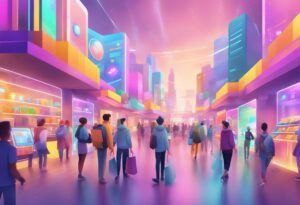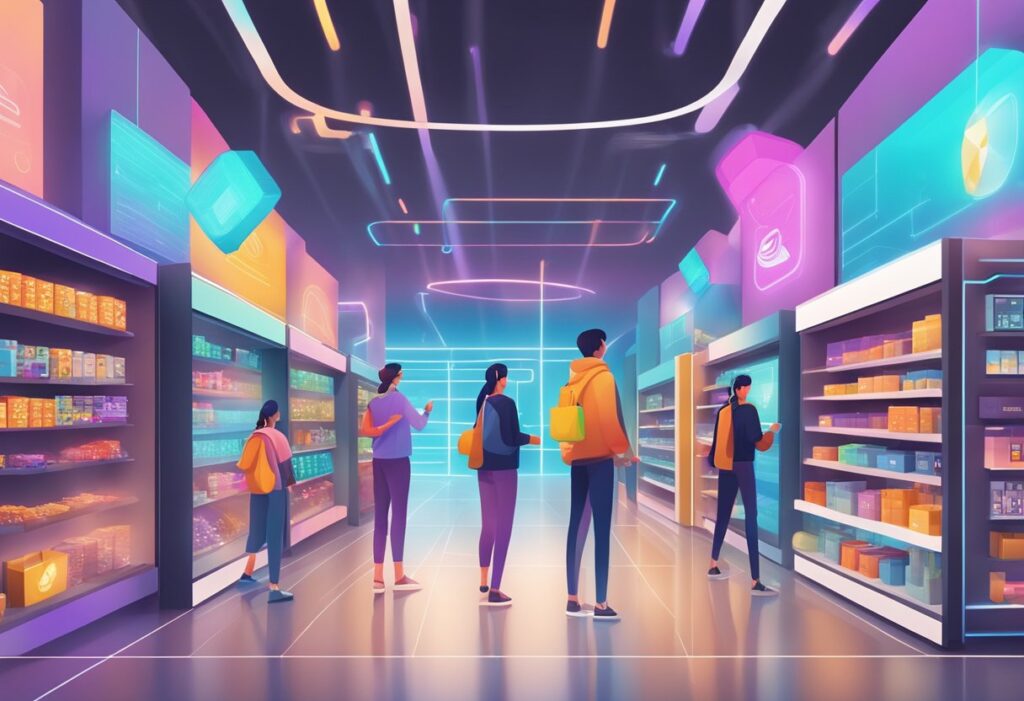Metaverse shopping is a relatively new concept that has emerged with the increasing popularity of the metaverse. The metaverse is a virtual space where users can interact with each other and digital objects in a three-dimensional environment. Metaverse shopping involves buying and selling goods and services in this virtual world, providing a new and innovative way for consumers to shop. In this blog post, you will learn about Metaverse Shopping; How it works and the items you can buy in a metaverse shop.
Virtual shopping experiences in the metaverse have the advantage of being able to track a customer’s activity, purchase history, taste, and demographic information. This data can be used to create personalized shopping experiences that are tailored to the individual’s needs and preferences. Retailers can also use this data to improve their marketing strategies and better understand their customers.
As the metaverse continues to grow, more and more retailers are exploring the potential of metaverse shopping. Brands like Gucci, Dyson, and Walmart have already entered the metaverse, offering immersive virtual experiences to their customers. With the rise of metaverse shopping, consumers can expect to see a new era of shopping experiences that are more engaging and personalized than ever before.
What is Metaverse Shopping
Metaverse shopping is a new form of online shopping that takes place in a virtual world known as the “Metaverse.” The Metaverse is a collective virtual shared space created by converging virtual reality (VR), augmented reality (AR), and other immersive technologies. In the Metaverse, users can interact with each other in real-time and engage in various activities, including shopping.
How Metaverse Shopping Works
Metaverse shopping works by allowing users to visit virtual stores and browse through products using their avatars. Users can interact with the products, view them from different angles, and even try them on virtually. They can also chat with other shoppers and get advice from virtual sales assistants.
Once the user has chosen the product, they can purchase it using virtual currency or real money. The product will then be delivered to their virtual address or their real-world address, depending on the retailer’s policies.
Benefits of Metaverse Shopping
Metaverse shopping offers several benefits over traditional online shopping. Firstly, it provides a more immersive and interactive shopping experience that allows users to engage with products in a more personalized way.
Secondly, it offers a social aspect to shopping, allowing users to interact with other shoppers and get advice from virtual sales assistants. Finally, it offers a safe and secure environment for shopping, as users can shop without worrying about physical theft or fraud.
What Can You Buy in a Metaverse Shop
In a Metaverse shop, users can buy a wide range of products, including clothing, accessories, home decor, and even virtual items such as avatars and virtual currency. Retailers can offer a vast selection of products without the limitations of physical space, allowing users to browse through a more extensive range of products than in a traditional store.
Metaverse shopping is a new and exciting way to shop that offers a more immersive and interactive experience than traditional online shopping. It provides a social aspect to shopping, allows users to interact with products in a more personalized way, and offers a safe and secure environment for shopping.
Brands with Shops in the Metaverse

The Metaverse has become a popular destination for brands to set up virtual shops, allowing them to connect with customers in a new and exciting way. Here are the top 10 brands with shops in the Metaverse and what they sell:
| Rank | Brand | Metaverse Platform | What They Sell |
|---|---|---|---|
| 1 | Nike | Roblox, Decentraland | Virtual sneakers, sportswear, RTFKT NFTs |
| 2 | Gucci | Roblox, The Sandbox | Virtual clothing, handbags, accessories, NFTs |
| 3 | Louis Vuitton | Decentraland | Virtual clothing, handbags, NFTs, exclusive experiences |
| 4 | Ralph Lauren | Roblox | Virtual clothing, accessories, limited edition NFTs |
| 5 | Burberry | Decentraland | Virtual clothing, accessories, NFTs, digital collectibles |
| 6 | Dolce & Gabbana | Decentraland | Virtual clothing, accessories, NFTs, fashion shows |
| 7 | Adidas | The Sandbox, Roblox | Virtual sneakers, sportswear, NFTs, collaboration with the Bored Ape Yacht Club |
| 8 | Balenciaga | Fortnite | Virtual clothing, accessories, collaborations with Fortnite characters |
| 9 | Coca-Cola | Decentraland | Virtual beverages, NFTs, metaverse events, digital collectibles |
| 10 | Samsung | Roblox | Virtual electronics, home appliances, NFTs, interactive experiences |
Nike
Nike has set up shop in Roblox, offering a range of virtual sneakers and apparel. The brand has also created a virtual basketball court where users can play games and show off their virtual Nike gear.
Gucci
Gucci has partnered with Roblox to create a virtual Gucci Garden experience, where users can explore a virtual garden and purchase digital Gucci items like bags, shoes, and hats.
Louis Vuitton
Louis Vuitton has created a virtual store in the Metaverse, offering a range of digital products like handbags, shoes, and accessories. The store also features virtual art installations and interactive experiences.
Ralph Lauren
Ralph Lauren has created a virtual store in the Metaverse, offering a range of digital products like clothing, accessories, and home decor. The store also features virtual art installations and interactive experiences.
Burberry
Burberry has set up shop in the Metaverse, offering a range of virtual clothing and accessories. The brand has also created a virtual runway show where users can watch models showcase the latest Burberry designs.
Dolce & Gabbana
Dolce & Gabbana has created a virtual store in the Metaverse, offering a range of digital products like clothing, accessories, and fragrances. The store also features virtual art installations and interactive experiences.
Adidas
Adidas has set up shop in Roblox, offering a range of virtual sneakers and apparel. The brand has also created a virtual basketball court where users can play games and show off their virtual Adidas gear.
Balenciaga
Balenciaga has partnered with Roblox to create a virtual store, offering a range of digital products like clothing, accessories, and sneakers. The store also features virtual art installations and interactive experiences.
Coca-Cola
Coca-Cola has created a virtual store in the Metaverse, offering a range of digital products like branded clothing, accessories, and collectibles. The store also features virtual vending machines where users can purchase virtual Coca-Cola products.
Samsung
Samsung has set up shop in the Metaverse, offering a range of virtual products like smartphones, tablets, and smartwatches. The brand has also created a virtual showroom where users can explore Samsung’s latest innovations.
These brands have successfully leveraged the Metaverse to offer unique and engaging experiences for their customers. By setting up virtual shops and creating interactive experiences, they have created a new way for users to connect with their brand and products.
How to Open a Shop in the Metaverse

Opening a shop in the Metaverse can be a great way to reach a wider audience and offer a unique shopping experience. Here are some steps to follow:
- Choose the right platform: There are several platforms available for setting up a shop in the Metaverse, such as Decentraland, The Sandbox, and Somnium Space. It is important to evaluate each platform’s features and capabilities before committing to one.
- Create a virtual storefront: Once the platform is chosen, it is time to create a virtual storefront. The storefront should be designed to provide an immersive and interactive shopping experience that is not possible in the real world.
- Customize the store: The store should be customized to reflect the brand’s identity and appeal to the target audience. This can include choosing the right colors, textures, and lighting for the store.
- List products: The products should be listed on the virtual storefront with clear descriptions, prices, and images. This will help customers make informed decisions about their purchases.
- Set up payment and shipping options: Payment and shipping options should be set up to ensure a smooth shopping experience. The payment options should be secure and reliable, while the shipping options should be fast and efficient.
- Promote the store: The store should be promoted through social media, email marketing, and collaborations with Metaverse influencers. This will help attract more customers to the store.
Technologies Powering Metaverse Shopping
The metaverse is a virtual space where people can interact with each other and digital objects in a simulated environment. Metaverse shopping is a new way of shopping that allows consumers to experience the products and services in a virtual environment. To make this possible, several technologies are powering the metaverse shopping experience.
Virtual and Augmented Reality
Virtual and augmented reality technologies are essential in creating a realistic shopping experience in the metaverse. Virtual reality (VR) is a technology that immerses users in a completely simulated environment, while augmented reality (AR) overlays digital content onto the real world. In metaverse shopping, VR helps create a virtual store where customers can browse products, while AR allows customers to see how products would look in their real-world environment.
Blockchain and NFTs
Blockchain technology and non-fungible tokens (NFTs) are also crucial in metaverse shopping. Blockchain provides a decentralized and transparent platform for metaverse transactions, while NFTs allow for unique digital assets to be created and traded. In metaverse shopping, blockchain and NFTs enable secure and transparent transactions for virtual goods and services.
Artificial Intelligence and Automation
Artificial intelligence (AI) and automation are also technologies powering metaverse shopping. AI algorithms can be used to personalize the shopping experience for customers, while automation can streamline the process of creating and managing virtual stores.
In metaverse shopping, AI and automation can help retailers provide a more efficient and personalized shopping experience for customers.
Metaverse shopping is a new way of shopping that is made possible by several technologies. Virtual and augmented reality, blockchain and NFTs, and artificial intelligence and automation are all essential in creating a realistic and personalized shopping experience in the metaverse.
The Metaverse Shopping Experience
As the metaverse continues to evolve, it is transforming the way people shop. The metaverse shopping experience offers a unique and immersive retail environment that allows customers to interact with products and brands in a virtual environment. This section will explore the key aspects of the metaverse shopping experience, including immersive retail environments, social shopping, and community.
Immersive Retail Environments
One of the main advantages of the metaverse shopping experience is the ability to create immersive retail environments that allow customers to engage with products in a virtual environment. Virtual stores can be designed to simulate real-world environments, providing customers with a more realistic shopping experience. Customers can explore virtual stores, interact with products, and even try on clothes using their avatars.
Virtual experiences can be designed to provide customers with a more personalized shopping experience. For example, virtual stores can be designed to provide customers with recommendations based on their preferences and past purchases. This can help increase customer engagement and loyalty.
Social Shopping and Community
Another key aspect of the metaverse shopping experience is social shopping and community. Customers can interact with other customers in virtual environments, share experiences, and even make purchases together. This can help create a sense of community and increase customer engagement.
Virtual environments can be designed to promote social shopping and community. For example, virtual stores can be designed to include social spaces where customers can interact with each other and share experiences. This can help create a more social and engaging shopping experience.
The metaverse shopping experience offers a unique and immersive retail environment that allows customers to interact with products and brands in a virtual environment. The ability to create immersive retail environments and promote social shopping and community can help increase customer engagement and loyalty.

Business Opportunities and Challenges
Retailer Strategies and Growth
The metaverse offers retailers a unique opportunity to expand their customer base and increase sales. With the rise of Gen Z consumers, who are more likely to shop online and prefer digital experiences, retailers can leverage the metaverse to create immersive shopping experiences that cater to the preferences of this demographic.
However, retailers will need to adopt an omnichannel approach and integrate their online and offline channels to maximize the potential of the metaverse.
To succeed in the metaverse, retailers will need to focus on creating personalized experiences that cater to the needs and preferences of their customers. By leveraging data and analytics, retailers can gain insights into the behavior of their customers and tailor their offerings accordingly. This can help improve conversion rates and increase brand loyalty.
Consumer Behavior and Brand Loyalty
In the metaverse, consumers are looking for experiences that are authentic, safe and secure. Retailers will need to focus on building trust with their customers by ensuring that their products are authentic and their transactions are secure. This can be achieved by implementing robust security measures and partnering with trusted third-party providers.
To build brand loyalty, retailers will need to create experiences that are engaging, immersive and personalized. By leveraging data and analytics, retailers can gain insights into the behavior and preferences of their customers and tailor their offerings accordingly. This can help increase brand loyalty and drive repeat purchases.
Security and Authenticity Concerns
One of the biggest challenges facing retailers in the metaverse is ensuring the security and authenticity of their products and transactions.
With the rise of digital marketplaces and the increasing use of cryptocurrencies, retailers will need to adopt robust security measures and partner with trusted third-party providers to ensure that their products are authentic and their transactions are secure.
To address these concerns, retailers can leverage blockchain technology to create a secure and transparent supply chain. This can help improve the authenticity of products and provide customers with greater confidence in their purchases.
Rretailers can implement robust security measures such as two-factor authentication and biometric identification to protect against fraud and cyber attacks.

Future Trends in Metaverse Commerce
Innovations in Digital Fashion
The integration of fashion and technology has been a growing trend in recent years, and the metaverse is no exception. In the digital world, fashion brands have the opportunity to experiment with new materials, designs, and styles that are not limited by the constraints of the physical world.
This has led to the emergence of digital fashion, which allows consumers to purchase virtual clothing and accessories to enhance their avatar’s appearance.
In addition, brands are also exploring the use of augmented reality (AR) and virtual reality (VR) technologies to create immersive shopping experiences.
For example, the virtual try-on feature allows customers to see how a particular outfit looks on their avatar before making a purchase. This trend is expected to continue, and we can expect to see more innovations in digital fashion in the future.
Expansion of Phygital Experiences
The concept of “phygital” (physical + digital) experiences has gained popularity in recent years, and it is expected to become even more prevalent in the metaverse. Brands are exploring ways to create seamless experiences that integrate the physical and digital worlds to provide a more engaging and personalized shopping experience.
For example, some brands are using QR codes and augmented reality to allow customers to access product information and reviews. Others are experimenting with virtual showrooms that allow customers to view and interact with products in a virtual environment.
This trend is expected to continue, and we can expect to see more brands leveraging phygital experiences to enhance their brand narrative.
Impact of Emerging Technologies
Emerging technologies such as blockchain, artificial intelligence (AI), and 5G are expected to have a significant impact on metaverse commerce in the future. Blockchain technology, for example, can be used to create secure and transparent transactions for virtual goods.
AI can be used to provide personalized recommendations and enhance the overall shopping experience. 5G can provide faster and more reliable connectivity, which is essential for immersive experiences.
The future of metaverse commerce is exciting, and we can expect to see more innovations in digital fashion, expansion of phygital experiences, and impact of emerging technologies. As brands continue to experiment and explore the potential of the metaverse, we can expect to see more personalized and engaging shopping experiences for consumers.
Frequently Asked Questions
What is metaverse shopping?
Metaverse shopping refers to the act of buying and selling products in virtual worlds. It involves creating 3D environments that simulate real-world shopping experiences, allowing users to browse, select, and purchase products from virtual storefronts.
Can you buy stuff in the metaverse?
Yes, you can buy stuff in the metaverse. Metaverse shopping is becoming increasingly popular, with more and more retailers setting up virtual storefronts to sell products.
What is an example of metaverse shopping?
One example of metaverse shopping is the virtual shopping mall, where users can browse and purchase products from a range of virtual storefronts. Another example is the virtual showroom, where users can view and purchase products in a 3D environment.
What stores are using metaverse?
Many stores are using metaverse to sell their products, including luxury brands like Gucci and Louis Vuitton, as well as retailers like Walmart and Target.
Is Walmart part of metaverse?
Yes, Walmart is part of metaverse. The retail giant has set up a virtual storefront in the metaverse, allowing users to browse and purchase products from the comfort of their own homes.
How do I open my shop in metaverse?
To open a shop in metaverse, you will need to create a 3D environment that simulates a real-world shopping experience. You can then set up a virtual storefront and start selling your products to users in the metaverse.
How much does it cost to open a store in metaverse?
The cost of opening a store in metaverse varies depending on the platform you choose and the complexity of your virtual storefront. Some platforms offer free tools for creating virtual storefronts, while others charge a fee for access to more advanced features.
How do I sell my product on metaverse?
To sell your product on metaverse, you will need to set up a virtual storefront and list your products for sale. You can then promote your storefront through social media and other marketing channels to attract users to your virtual storefront.
What is a metaverse storefront?
A metaverse storefront is a virtual storefront that allows users to browse and purchase products in a 3D environment. It is designed to simulate a real-world shopping experience, with virtual shelves, displays, and product listings.














